How To Care For Juniper Roots
Why Is Root Care Important?
A healthy root system is critical to the overall well-being of any plant. Juniper roots perform several essential functions. Most notably, the roots are responsible for absorbing nutrients and water from the soil. Similarly, the roots frequently store whatever energy the plant produces via photosynthesis until that energy is needed for something.
However, the roots also serve to protect the plant from wind damage or being washed away by firmly anchoring it in the soil. On top of all of this, various microorganisms (such as bacteria or fungi) that live in the soil are supported by root systems. These microorganisms can provide plants with a host of benefits, ranging from supplying necessary nutrients to serving as a form of antibiotic.

How To Take Care of Juniper Roots
Pruning Roots
Ideally, you should prune the roots of your juniper bonsai every other year between March and May. To do this, you should begin by carefully taking the plant out of its pot. You’ll then have to dispose of some of the soil clinging to the sides and the bottom of the roots.
Trim off one-third of the roots all around and then up from the bottom. When you replant the bonsai, make sure to do so with fresh soil. Once you have repotted your juniper bonsai, you should mist the plant with water. It may also be a good idea to soak your bonsai in a solution of Vitamin B-1 transplant mixed with water.
Repotting
A mature bonsai generally only needs to be repotted once every three or four years. A young bonsai, however, usually needs to be repotted every two years. To check whether your bonsai needs to be repotted, remove it from its pot and inspect the roots.
If the bonsai no longer has any room to expand in its current pot, the roots will have formed multiple circles around themselves. If you see this, your bonsai either needs a new pot, or it needs new soil–or both. When checking the bonsai, make sure you grasp it near the base of the trunk, where it is sturdier.
Root Disease
The primary root disease that you need to worry about is root rot. It’s a critical condition caused by fungi such as phytophthora. As the name suggests, root rot causes the roots to decay. Left untreated, root rot will eventually kill any infected bonsai. Symptoms of root rot may include:
- Slowed rates of growth
- Blackened or yellowing leaves
- Soil and/or roots smelling of rot
- Mushy roots and/or leaves
- Delayed blooming
- Loss of leaves
- Discolored roots (healthy roots should be white and firm)
- Drooping or wilted leaves
- Fungus gnats living in the soil around your plant
Early detection is critical in successfully treating this particular condition. It’s primarily because the treatment for root rot is to remove the infected portions of the root rather than restore them. Consequently, if the roots are infected past a certain point, this method won’t do much to help your plant.
Accordingly, the best course of treatment is prevention. Luckily, root rot isn’t too hard to avoid as long as you are familiar with the most common causes. These include overwatering, poor drainage, and contagion from an infected plant.
Soil Choice
Juniper is a hardy plant, and it is capable of handling a broad range of soils. However, a juniper bonsai generally does best with light sandy soil. This soil should be somewhere between moderately acidic to mildly alkaline.
Ideally, between 6.0 and 7.5 on the pH scale would be a good range to aim for. Fortunately, you shouldn’t have too much trouble with locating soil that fulfills this requirement, since the majority of average garden soils are somewhere between 6.0 and 7.0 on the pH scale.
You can test the soil pH with an inexpensive soil pH tester probe. If the pH is too high, you can lower it by adding aluminum sulfate, soil sulfur, or chelated iron to the soil. If it is too low, try adding pelletized limestone to the earth.
Keep in mind that juniper is a drought-tolerant plant and thus doesn’t need high amounts of water. This low water need puts a juniper bonsai at higher risk of root damage or disease if it suffers from overwatering or poor soil drainage.
Consequently, even if you don’t select a light sandy soil, you should take care to ensure whatever soil you do choose drains well and wait until the soil near your juniper bonsai has largely dried out before watering.
Fertilizer Choice
A juniper bonsai should be treated with fertilizer at least once every three weeks. Depending on your personal preferences, you can use a monthly organic fertilizer during the growing season or a weekly liquid fertilizer.
The best fertilizer to use largely depends on the time of year. During the fall, for instance, a fertilizer that is low in nitrogen content is preferable, while a high-nitrogen fertilizer is best during the spring since this will encourage growth.
However, you can settle for simply watering throughout winter since there is not typically a need to fertilize–juniper will usually go dormant during the colder months. In summer, it may be better to let your bonsai rest. If you decide to fertilize, using a more balanced fertilizer is ideal. Avoid fertilizing soon after repotting since doing so might shock the roots.







